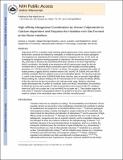High-Affinity Manganese Coordination by Human Calprotectin Is Calcium-Dependent and Requires the Histidine-Rich Site Formed at the Dimer Interface
Author(s)
Hayden, Joshua A.; Brophy, Megan Brunjes; Cunden, Lisa Stephanie; Nolan, Elizabeth Marie
Downloadnihms432410.pdf (2.111Mb)
PUBLISHER_POLICY
Publisher Policy
Article is made available in accordance with the publisher's policy and may be subject to US copyright law. Please refer to the publisher's site for terms of use.
Terms of use
Metadata
Show full item recordAbstract
Calprotectin (CP) is a transition metal-chelating antimicrobial protein of the calcium-binding S100 family that is produced and released by neutrophils. It inhibits the growth of various pathogenic microorganisms by sequestering the transition metal ions manganese and zinc. In this work, we investigate the manganese-binding properties of CP. We demonstrate that the unusual His₄ motif (site 2) formed at the S100A8/S100A9 dimer interface is the site of high-affinity Mn(II) coordination. We identify a low-temperature Mn(II) spectroscopic signal for this site consistent with an octahedral Mn(II) coordination sphere with simulated zero-field splitting parameters D = 270 MHz and E/D = 0.30 (E = 81 MHz). This analysis, combined with studies of mutant proteins, suggests that four histidine residues (H17 and H27 of S100A8; H91 and H95 of S100A9) coordinate Mn(II) in addition to two as-yet unidentified ligands. The His₃Asp motif (site 1), which is also formed at the S100A8/S100A9 dimer interface, does not provide a high-affinity Mn(II) binding site. Calcium binding to the EF-hand domains of CP increases the Mn(II) affinity of the His₄ site from the low-micromolar to the mid-nanomolar range. Metal-ion selectivity studies demonstrate that CP prefers to coordinate Zn(II) over Mn(II). Nevertheless, the specificity of Mn(II) for the His₄ site provides CP with the propensity to form mixed Zn:Mn:CP complexes where one Zn(II) ion occupies site 1 and one Mn(II) ion occupies site 2. These studies support the notion that CP responds to physiological calcium ion gradients to become a high-affinity transition metal ion chelator in the extracellular space where it inhibits microbial growth.
Date issued
2013-01Department
Massachusetts Institute of Technology. Department of ChemistryJournal
Journal of the American Chemical Society
Publisher
American Chemical Society (ACS)
Citation
Hayden, Joshua A. et al. "High-Affinity Manganese Coordination by Human Calprotectin Is Calcium-Dependent and Requires the Histidine-Rich Site Formed at the Dimer Interface." Journal of the American Chemical Society 135, 2 (January 2013): 775–787 © 2012 American Chemical Society
Version: Author's final manuscript
ISSN
0002-7863
1520-5126